Write TRUE if the statement is true and if the statement is false, change the underlined word/s to make it true. 1. The distribution of sample means is when samples of the same size are selected from a population and the means are computed. 2. The sample means are always the same as the population mean. 3. The standard error of the mean is the standard deviation of the sample means. 4. The standard deviation of the sample means is smaller than the population standard deviation. 5. According to the central limit theorem, the distribution of sample means is approximately normal for any sample size. 6. A sample size is considered large if it is at least 20. 7. The standard error of the mean is equal to the population standard deviation divided by the square root of a sample size. 8. If the original random variable is normally distributed, the distribution of the sample means is not normally distributed for any sample size. 9. If the original random variable is not normally distributed, a sample size of 20 or more is needed to use a normal distribution to approximate the distribution of the sample means. 10. The smaller the sample size, the better the approximation of the normal distribution is.
Write TRUE if the statement is true and if the statement is false, change the underlined word/s to make it true. 1. The distribution of sample means is when samples of the same size are selected from a population and the means are computed. 2. The sample means are always the same as the population mean. 3. The standard error of the mean is the standard deviation of the sample means. 4. The standard deviation of the sample means is smaller than the population standard deviation. 5. According to the central limit theorem, the distribution of sample means is approximately normal for any sample size. 6. A sample size is considered large if it is at least 20. 7. The standard error of the mean is equal to the population standard deviation divided by the square root of a sample size. 8. If the original random variable is normally distributed, the distribution of the sample means is not normally distributed for any sample size. 9. If the original random variable is not normally distributed, a sample size of 20 or more is needed to use a normal distribution to approximate the distribution of the sample means. 10. The smaller the sample size, the better the approximation of the normal distribution is.
Glencoe Algebra 1, Student Edition, 9780079039897, 0079039898, 2018
18th Edition
ISBN:9780079039897
Author:Carter
Publisher:Carter
Chapter10: Statistics
Section10.4: Distributions Of Data
Problem 22PFA
Related questions
Question
100%

Transcribed Image Text:INDEPENDENT TASK 1
Write TRUE if the statement is true and if the statement is false, change the underlined word/s to make
it true.
1. The distribution of sample means is when samples of the same size are selected from
a population and the means are computed.
2. The sample means are always the same as the population mean.
3. The standard error of the mean is the standard deviation of the sample means.
4. The standard deviation of the sample means is smaller than the population standard
deviation.
5. According to the central limit theorem, the distribution of sample means is
approximately normal for any sample size.
6. A sample size is considered large if it is at least 20.
7. The standard error of the mean is equal to the population standard deviation divided
by the square root of a sample size.
8. If the original random variable is normally distributed, the distribution of the sample
means is not normally distributed for any sample size.
9. If the original random variable is not normally distributed, a sample size of 20 or
more is needed to use a normal distribution to approximate the distribution of the
sample means.
10. The smaller the sample size, the better the approximation of the normal distribution
is.
Expert Solution
This question has been solved!
Explore an expertly crafted, step-by-step solution for a thorough understanding of key concepts.
This is a popular solution!
Trending now
This is a popular solution!
Step by step
Solved in 6 steps

Knowledge Booster
Learn more about
Need a deep-dive on the concept behind this application? Look no further. Learn more about this topic, probability and related others by exploring similar questions and additional content below.Recommended textbooks for you

Glencoe Algebra 1, Student Edition, 9780079039897…
Algebra
ISBN:
9780079039897
Author:
Carter
Publisher:
McGraw Hill

Glencoe Algebra 1, Student Edition, 9780079039897…
Algebra
ISBN:
9780079039897
Author:
Carter
Publisher:
McGraw Hill